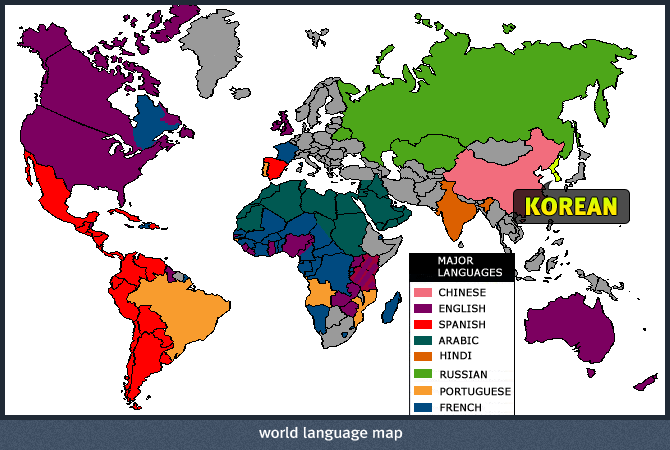|
|
|
|
|
|
|
| |
 |
ow many languages are there in the world?
Since there are various races and people in the world, their languages must vary.
There are about 5,000 different languages, worldwide. Korea has ranked 13th place in number of people using Hangeul,following Chinese, English, Spanish, Hindi, Arabic,Bengalese, Russian, Portuguese,Japanese,German,Fre
|
|
-nch and Punjabi. Korean language is not used only in South and North Korea. About 67 million of people in South and North Korea, 2 million in China, 1.8 million in the US, 0.7 million in Japan, 0.5 million in the former Soviet Union including Russia and Kazakhstan also speak Korean, tallying up to about 70 million people.The number is still soaring as Korea emigrants have started to move to Australia and Europe. (Reference: world language map) |
| |
 |
| |
What is the current status of the official record recording the usage of language in text?
Although thousands of languages exist worldwide, only few are recorded as a text. This is because alphabets are used in transcription for many languages or there are languages without any alphabets to record as a text.
The most widely used alphabetic writing system in the world is Roman alphabets. Roman alphabets are also called Latin alphabet, which is now mainly used in many European countries and the American Continent. The alphabets of different European languages including English, French and German, have originated from Roman. Cyrillic alphabet, which derived from Greek alphabet, is used in Russia and the areas of former Soviet Union. Greek alphabets are still used in Greece. Arabic characters are also used widely. They are written from right to left, on the contrary of many other alphabets written from left to right and are used in various countries including the Middle East, Central Asia, Southwest Asia, Southeast Asia and Africa that were influenced by Islamic culture. Indian alphabets differ by regions in India. Chinese alphabet which is based on an idiogram has evolved over 4,000 years, whereas Hangeul, a Korean writing system which is composed of 14 consonants and 10 vowels, was invented by King Sejong in 1443.
Let’s take a look at various languages mentioned above.
|
| |
 |
| |
 |
| |
 |
| |
Many alphabets throughout the world can be classified into phonetic and semantic symbols. Semantic symbols, also known as ideogram, are the alphabets that have definite meanings for each letter. Chinese characters are the best example. On the other hand, phonetic symbols are also called phonogram and they literally express the sound of human voice. They include Hangeul, Roman and Arabic alphabets. Phonetic symbols can be subdivided once more into syllabic and phonemic alphabets. A syllable is a synthetic unit of sounds and phonemic alphabets counterpart with each phoneme. Both human culture and alphabets have been developed economically and efficiently. Pictures have been simplified and abstracted to phonetic symbols and developed into syllabic alphabets which can be expressed in sounds represented by relatively fewer alphabets. Among diverse range of languages used in the world, Hangeul is considered as the most developed language with phonemic alphabets. It has a special stroke-adding system taking ‘ㄲ,’ and ‘ㅋ’ on a basis of ‘ㄱ.’ Some scholars classify Hangeul as a feature alphabet. Such characteristic is a strong point of Hangeul in the era of IT development and a national competitiveness in the future. |
|
|
|
|
